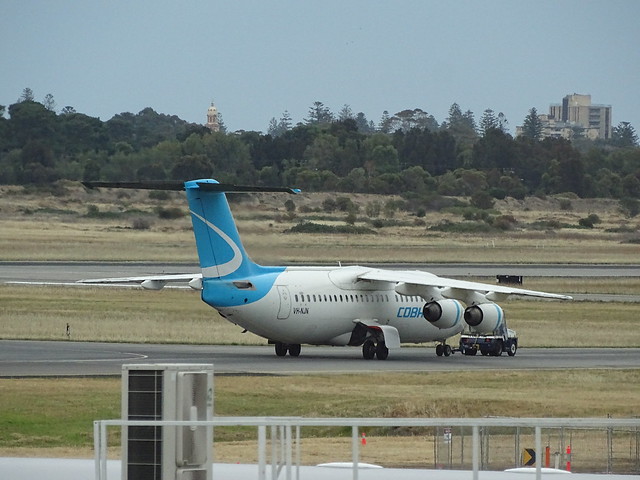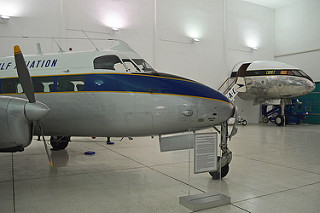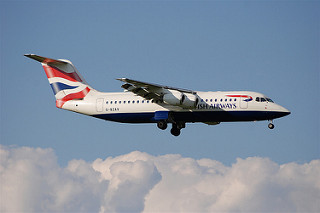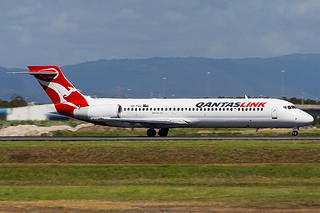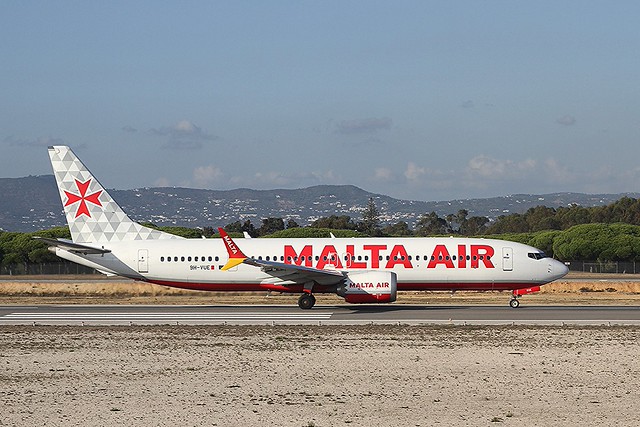Cobham RJ1H at Perth on Apr 29th 2014, uncontained engine failure
Last Update: May 2, 2016 / 13:51:23 GMT/Zulu time
Incident Facts
Date of incident
Apr 29, 2014
Classification
Incident
Airline
Cobham Aviation Services
Aircraft Registration
VH-NJI
Aircraft Type
AVRO RJ-100 Avroliner
ICAO Type Designator
RJ1H
Contributing factors
- A repair to the two o’clock combustion liner retention boss of the No. 2 engine combustor turbine module housing was not performed in accordance with the manufacturer’s repair specification, resulting in a thin-walled housing that increased local stresses in that location.
- As a result of fatigue, the No. 2 engine combustor turbine module housing cracked, then fractured adjacent to the two o’clock combustion liner retention boss weld, propagating at an unpredictable rate as a result of the non-approved repair.
- High-temperature combusting fuel and gases escaped radially from the fracture in the No. 2 engine combustor turbine module housing, leading to an in-flight engine fire.
Other factors that increased risk
- The Honeywell International Inc documentation for blending did not limit the amount of material that could be removed from the combustor housing.
Other findings
- The Honeywell International Inc LF507-1F heavy maintenance schedule was adequate to identify and repair cracks in the combustor turbine module housing combustion liner retention boss weld.
The ATSB describe maintenance actions:
A non-penetrating crack, a crack that did not penetrate through the full thickness of the housing sheet metal, had propagated over a period of about 2,680 load cycles. Each load cycle on the affected components was considered by Honeywell to be associated with pressure variations within the engine. Pressure variations can be caused by engine power level changes, compressor stalls, combustion rumble and temperature variations that lead to expansion and contraction of the housing. Numerous load cycles can occur during normal flight.
Engine maintenance is based on engine hours, cycles4 or calendar days, depending on the type of component. Engine maintenance is not based on load cycles as each flight can produce a significant variation due to conditions at that time. The examination of the fractured welded boss identified three separate weld repairs. These were identified on cross-sectional samples taken through the joints surrounding the recovered welded boss (figure 5). Honeywell concluded that the fatigue cracking was not directly associated with the weld. Hardness measurements taken from the housing sheet metal, boss casting, and weld indicated that heat treatment was performed on the assembly subsequent to weld repair, as specified by Honeywell.
Further examination of the combustor housing in the location of the fractured welded boss found that a section of the combustor housing sheet metal had been thinned at the inside and outside surfaces by grinding (Figure 6). This grinding was associated with a weld repair where the boss was weld fused to the sheet metal. Thicknesses of 0.035 inches–0.040 inches were measured at the CTM housing adjacent to the two o’clock welded boss.
The thickness of the combustor housing sheet metal was specified by Honeywell as nominally 0.049–0.050 inches thick. This indicated that during a repair, about 20–30 per cent of the housing thickness had been removed. In this regard, the combustor housing is a pressure vessel. Honeywell does not approve the removal of material leading to a reduction of housing wall thickness.
The ATSB analysed: "At a high engine power setting during the climb, the welded boss at the two o’clock position of the No. 2 Honeywell International Inc (Honeywell) LF507-1F engine fractured and separated from the combustor turbine module (CTM) combustor housing (housing). This led to the fracture of the combustion lining and allowed high-pressure combusting fuel and gases to escape radially from the engine. The engine cowling was weakened and melted from the resulting in-flight engine fire. The engine fire detection and suppression system was effective in alerting the crew to the situation. The crew extinguished the fire using normal operating procedures and returned the aircraft to Perth Airport for landing."
The ATSB analysed with respect to the non-approved repair: "Metallurgical examination of the fractured welded boss found that it had been weld-repaired on three separate occasions. The only recorded weld repair to the CTM housing was in 2005 although, as the CTM housing was an exchanged unit, its history could not be established. Therefore, either the CTM housing was repaired at or prior to 2005, or the housing was repaired after 2005 and the repair was not recorded. From the evidence available, the ATSB could not determine which was the case. In any event, the housing had been ground adjacent to the welded boss, reducing the housing wall thickness by 20–30 per cent. Grinding of the housing was not in accordance with Honeywell’s approved repair scheme, and the non-approved repair was not identified in any of the subsequent heavy maintenance inspections. The reduction in the housing wall thickness increased the operational stresses at that location. This would have affected the initiation of the fatigue crack and increased its rate of propagation during normal engine operation."
The final report references another engine fire on Mar 10th 2016, see Incident: Swiss RJ1H at Zurich on Mar 10th 2016, rejected takeoff due to sparking engine as "subsequent occurrence".
Figure 5: Metallographic image of a cross section of the fractured
welded boss. The red dots likely indicate the original weld. The
white, yellow and black dots likely indicate subsequent weld
repairs. The red arrows indicate a crack emanating from the forward
side of the weld at the housing/casting interface. The white arrow
is the fracture surface, where the boss separated from the combustor
housing. The fracture initiated at the outside diameter of the
Incident Facts
Date of incident
Apr 29, 2014
Classification
Incident
Airline
Cobham Aviation Services
Aircraft Registration
VH-NJI
Aircraft Type
AVRO RJ-100 Avroliner
ICAO Type Designator
RJ1H
This article is published under license from Avherald.com. © of text by Avherald.com.
Article source
You can read 2 more free articles without a subscription.
Subscribe now and continue reading without any limits!
Read unlimited articles and receive our daily update briefing. Gain better insights into what is happening in commercial aviation safety.
Send tip
Support AeroInside by sending a small tip amount.
Related articles
Cobham RJ1H at Port Augusta on May 26th 2021, near collision with light aircraft in traffic circuit
A Cobham Aviation Avro RJ-100, registration VH-NJE performing flight NC-788 from Adelaide,SA to Port Augusta,SA (Australia) with 37 passengers and 4…
Cobham B463 at Perth on Aug 21st 2019, flaps problem
A Cobham Aviation British Aerospace BAe 146-300, registration VH-NJN performing flight NC-974 from Perth,WA to Meekatharra,WA (Australia), was on…
Cobham RJ1H at Perth on Nov 6th 2018, engine shut down in flight
A Cobham Aviation Avro RJ-100, registration VH-NJP performing flight NC-1990 from Perth,WA to Barrow Island,WA (Australia), was climbing through…
Cobham RJ1H near Adelaide on Aug 30th 2018, two engines vibrated
A Cobham Aviation Avro RJ-100, registration VH-NJY performing flight NC-219 from Prominent Hill,SA to Port Augusta,SA (Australia), was enroute at…
Cobham B712 near Melbourne on Sep 29th 2017, engine trouble
A Cobham Aviation Boeing 717-200 on behalf of Qantas, registration VH-YQU performing flight QF-1535 from Canberra,AC to Melbourne,VI (Australia), was…
Newest articles
Malta B38M at Krakow on Dec 8th 2025, sun visor temporarily shuts engine down
An Air Malta Boeing 737-8 MAX on behalf of Ryanair, registration 9H-VUE performing flight FR-3505 from Krakow (Poland) to Milan Bergamo (Italy), was…
Hokkaido AT42 at Okushiri on Dec 16th 2025, problems with left aileron
A Hokkaido Air System Avions de Transport Regional ATR-42-600 on behalf of JAL Japan Airlines, registration JA13HC performing flight JL-2891 from…
Subscribe today
Are you researching aviation incidents? Get access to AeroInside Insights, unlimited read access and receive the daily newsletter.
Pick your plan and subscribePartner

ELITE Simulation Solutions is a leading global provider of Flight Simulation Training Devices, IFR training software as well as flight controls and related services. Find out more.
SafetyScan Pro provides streamlined access to thousands of aviation accident reports. Tailored for your safety management efforts. Book your demo today
AeroInside Blog
Popular aircraft
Airbus A320Boeing 737-800
Boeing 737-800 MAX
Popular airlines
American AirlinesUnited
Delta
Air Canada
Lufthansa
British Airways
